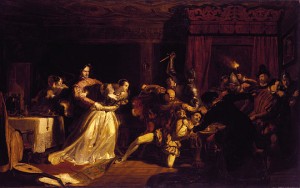My New Year’s Resolution for 2018 is to read a book (or listen to an unabridged audiobook) every day: 365 books by December 31. I will post my reviews here each week and provide regular updates on Twitter and Goodreads. Recommendations are always welcome!
Week 22: Fun Novels and Unexpected Royal References: Over the course of year, I have read more non-fiction than fiction. Where there have been novels on my reading list, they have mostly been historical fiction, dramatizing the lives of historical kings and queens. In the past few weeks, I have attempted to introduce more of a balance by reading fun novels that are not about royalty, at least on the surface.
I discovered that there are often royal references in the most unexpected places. Billy Lynn’s Long Halftime Walk by Ben Fountain references a state dinner to the United States by Charles and Camilla where one of the attendees discovered common ground with the royal couple by talking about hunting and shooting. A would-be Russian Revolutionary in The 100-Year-Old Man Who Climbed Out the Window and Disappeared by Jonas Jonasson loses interest in his cause because he begins to empathize with Czar Nicholas II who was having “a spell of bad luck” that lasted until the very end of his life.
Unexpected royal references are even more common in fiction set in the United Kingdom. It’s seemingly impossible to write a novel like Daisy Goodwin’s The American Heiress, which features English country house parties in the 1890s, without the future King Edward VII (who greatly admired American heiresses) appearing as one of the guests. The 44 Scotland Street series by Alexander McCall Smith features different varieties of monarchism from supporters of Queen Elizabeth II and her family to modern day Jacobites. The cultural influence of royal history extends far beyond books that focus on royalty. Here are this week’s reviews:

Genre: Fiction
Acquired: Purchased from BMV Books, Toronto
Format: Paperback, 307 pages
Date: June 9-10, 2018
Review: My book club selected this novel for the month of June. An enjoyable satire of American culture, especially celebrity worship. There are also some very funny scenes set in country clubs and corporate boxes that give a sense of the complicated attitudes toward the military in the United States, informed by social class, as the Bravos encounter numerous well wishers who just not sure what to say to them. Although the book is set more than a decade ago, the cultural references are surprisingly current with the characters excited about the possibility of meeting Beyonce and conversations about Charles and Camilla visiting the United States and dining at the White House. An engaging read.

Genre: Fiction
Format: Audiobook, 11 hours and 12 minutes
Acquired: Purchased from Audible.com
Dates Listened: June 12-14, 2018
Review: A novel about a dysfunctional American family preparing for the wedding of their beautiful, wealthy, charitable half-sister at an English country estate. The perspective rotates among the major characters but the tone is consistently snarky and cynical. Some scenes are quite funny but the narrative also drags in places and it seems to take too long for the family to arrive in Britain for the wedding festivities. The audiobook is well read by two different narrators, who are quite good at imitating English accents, making the scene where Alice runs up the room service bill at Claridge’s especially entertaining. A fun read that could have been even more entertaining with some careful editing.

Genre: Fiction
Acquired: Purchased from Audible.com
Format: Audiobook, 11 hours and 8 minutes
Dates Listened: June 14-15, 2018
Review: I have made many efforts to read Tolkien’s work in the past because people I know have recommended it to me and I have seen the movies. This audiobook of The Hobbit is the first time that I have completed one of Tolkien’s novels. The narrator is very enthusiastic about the material and brings a lot of energy to the voices and singing. The audiobook is a relaxing listen except for the section where the dwarves are battling giant spiders and I increased the reading speed to get that section done as quickly as possible.
I found the story fairly boring overall, however, and had difficultly telling the singing dwarves apart. There are too many descriptions of daily life on the road including all the walking and frequent hobbit mealtimes. There are some engaging scenes such as the exchange of riddles between Bilbo and Gollum and I respect Tolkien’s ability to create a fully realized fictional world but his work does not particularly appeal to me.

Genre: Classic Fiction
Acquired: Purchased from Audible.com
Format: Audiobook, 10 hours and 55 minutes
Dates Listened: June 15-18, 2018
Review: Robinson Crusoe was first published in 1719 and large sections of the book are either dull or painfully dated. Robinson’s patronizing attitude toward Friday is especially tiresome. The novel also shows little character development as Robinson’s views and outlook on the world seem to remain the same despite living for more than 25 years on a desert island.
The scenes where Robinson Crusoe figures out how to survive on the island, including hunting, raft building and farming, however, are fascinating and have lasting cultural significance, informing subsequent novels from Swiss Family Robinson to The Martian. The novel is worth reading for it’s influence on cultural history and insights concerning the attitudes of early eighteenth century Britain.

Genre: Fiction
Format: Paperback, 343 pages
Acquired: Purchased from Re-Reading Books, Toronto
Date Read: June 16, 2018
Review: I always enjoy Alexander McCall Smith’s novels and The World According to Bertie is an especially enjoyable contribution to the #44 Scotland Street series. Although Bertie, the saxophone playing gifted child and his overbearing mother are at the centre of the story, there is a whole cast of entertaining characters who are connected to each other in surprising ways including an art gallery owner with a good heart but poor fashion sense (distressed-oatmeal sweaters), a globe trotting anthropologist, a monarchist cafe owner who defends Prince Charles’s reputation and a modern day Jacobite who notes that the current Stuart candidate to the throne is German. I also like how McCall Smith includes bits of Edinburgh history and geography in the novel. Looking forward to reading the rest of the series!

Acquired: Purchased from Re-Reading Books, Toronto
Format: Paperback, 455 pages
Genre: Fiction
Date Read: June 17, 2017
Review: A blend of romance and historical fiction about a fictional American heiress, aptly named Cora Cash, who meets and marries a mysterious Duke and gradually learns his secrets and the secrets of British high society. The future Edward VII, who admired American women, makes some appearances at English country house parties and plays a key role in diffusing a confrontation between Cora and an especially unpleasant character.
There are a few scenes that are a bit over the top but so was the gilded age of the 1890s. While the novel is enjoyable to read and illustrates the differences between the British and American elites in the late nineteenth century, I would have liked more depth for the secondary characters. The confident Cora and her perceptive lady’s maid, Bertha, come alive but the Duke never really comes into focus until the rushed ending and Cora’s overbearing mother seems to fade from view as the novel progresses. A fun read but not especially memorable.

Genre: Fiction
Format: Audiobook, 12 hours
Acquired: Purchased from Audible.com
Dates Read June 18-19, 2018
Review: A quirky historical novel that features cameos by historical figures from Czar Nicholas II (“A spell of bad luck that lasted right up to the end.”) to Einstein to Kim Jong Il. The author has a dry sense of humour and the ability to present an over the top, almost farcical plot in an amusingly deadpan manner. The 100 year old man’s past, which intersects with key events in the 20th century, is juxtaposed with his modern day adventures escaping the nursing home. Entertaining, but I probably prefer The Girl Who Saved the King of Sweden on Jonasson’s novels as it has a more cohesive plotline and fewer characters to keep straight. The audiobook is well read by Steven Crossley.



































